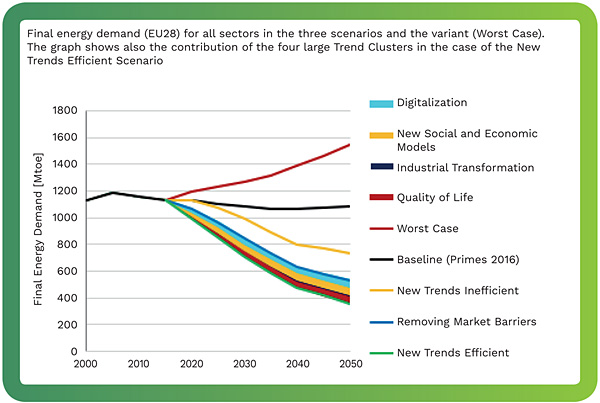Digitalization has the possibility to fundamentally change the current ways things are done. From the digitalization in private households (as for example voice control systems, smart thermostats and streaming operators), to digitalization in the transport sector (autonomous electric cars with smart loading infrastructure), to increasingly digitalized processes in the industry which can be highly optimized through automation.

While most of these processes are getting more and more efficient, not all of them are designed in a way that reduces energy. If we take the example of autonomous cars: the cars themselves will most certainly be more efficient, drive in a more efficient manner and by themselves create less accidents and less traffic jam. However, the more comfortable autonomous driving gets and the more advantages it copies from the current transport mode of train riding (e.g. being able to use the travel time to work, read, sleep), the more likely it is that people who can afford it will switch to this mode of transport. Thereby increasing their absolute energy demand, rather than decreasing it. The effects of autonomous driving on energy demand are thus manifold and it is not straightforward to access their overall impact. In their current study, Wadud et.al (2016) conclude that depending on the scenario the total road transport energy in the US might be reduced by 40% or increased by up to 100% until 2050 through automation.
Another example is the development of mobile phones. While getting more efficient the additional services of today's mobile phones need substantially more energy, including increasing energy demand of datacenters. On the other hand today's mobile phones do not only provide new services, but also make previous commodities unnecessary (such as cameras, Walkmans, recorders, etc.) thereby reducing the number of appliances and their lifetime energy demand.
These examples show that the ways in which digitalization and automation effects energy demand are not trivial to access. At the same time, trends such as digitalization – but also other trends like the sharing economy, the circular economy or urbanization – have huge potential to influence energy demand – negatively or positively – depending on their characteristics. In particular, new societal trends could lead to an increase in energy demand if they are not countered by measures with a strong focus on saving energy.
The objective of energy demand scenarios is to model future demand. These usually consider efficiency improvements and policy measures. So far, they do not systematically include the effect of above described societal trends.
Therefore, in 2018 Fraunhofer ISI conducted the "Study on Energy Savings Scenario 2050". The aim of the study was to develop European energy scenarios that consider potential societal trends in order to quantify the changes in energy demand resulting from them.
Here fore, energy-relevant societal trends were selected and quantified as far as possible based on detailed studies and on extensive stakeholder consultation at the European level. The following three scenarios were developed:
- 1. In the Removing Market Barriers Scenario, it was determined which (techno-economic) energy efficiency potentials could be realized by (almost) cost-efficient investments.
- 2. The New Trends Inefficient Scenario is characterized by strong, non-linear societal trends that can result, for example, from rebound effects of the sharing economy and digitalization. In a “worst case” variant of this scenario, the trends cause increasing energy demand without the techno-economic energy efficiency potentials being exploited.
- 3. The New Trends Efficient Scenario is also characterized by strong, non-linear societal trends. This scenario determines how much energy demand could decline if trends contribute strongly to reducing energy demand.

Key findings:
- If the techno-economic potentials
- including the ones arising
through digitalization - are
realized (in the Removing Market Barriers Scenario), final energy demand in Europe could decrease
substantially by up to 51% (relative
to the reference scenario).
- If there is no focus on reducing
energy demand when developing
societal trends (New Trends
Inefficient Scenario), this will counteract reductions achieved
due to the techno-economic
potentials. This means, the
scenario only achieves a 32%
reduction of European energy demand. This is for example
the case when digital processes
become more and more efficient,
but also drastically increase in
volume, therefore leading to an
increased energy demand (as
compared to the Removing Market Barriers Scenario).
- If, in addition, the techno-
economic potentials are not realized, for example due to a hesitant energy efficiency policy (worst case variant), then final energy demand could increase
substantially by 42%.
- If, in contrast, new societal trends
are supported by a strong focus
on energy demand reduction (New Trends Efficient Scenario), energy demand could be up to 67% lower in 2050. This scenario is only achievable if the trends unfold in a way that puts a decreasing energy demand first (supported by the
respective legislation).
The work conducted for the "Study on Energy Savings Scenario 2050"
summarizes existing knowledge on
the correlation between societal trends and energy demand in a pioneering study. It clearly reveals the
strong influence that new trends can
have on energy demand. The "Study on Energy Savings Scenario 2050"
was published in January 2019 and
forms the prelude to more intensive
research on the impact of new societal trends on energy demand.
Brugger, H.; Eichhammer, W.; Dönitz, E. (2019): Study on Energy Savings Scenarios 2050.
https://www.isi.fraunhofer.de/content/dam/isi/dokumente/ccx/2019/Summary_Energy-Savings-Scenarios-2050.pdf
Wadud, Z., MacKenzie, D., Leiby, P., 2016. Help or hindrance? The travel, energy and carbon impacts of highly automated vehicles. Transportation Research Part A: Policy and Practice 86, 1–18.
https://doi.org/10.1016/j.tra.2015.12.001